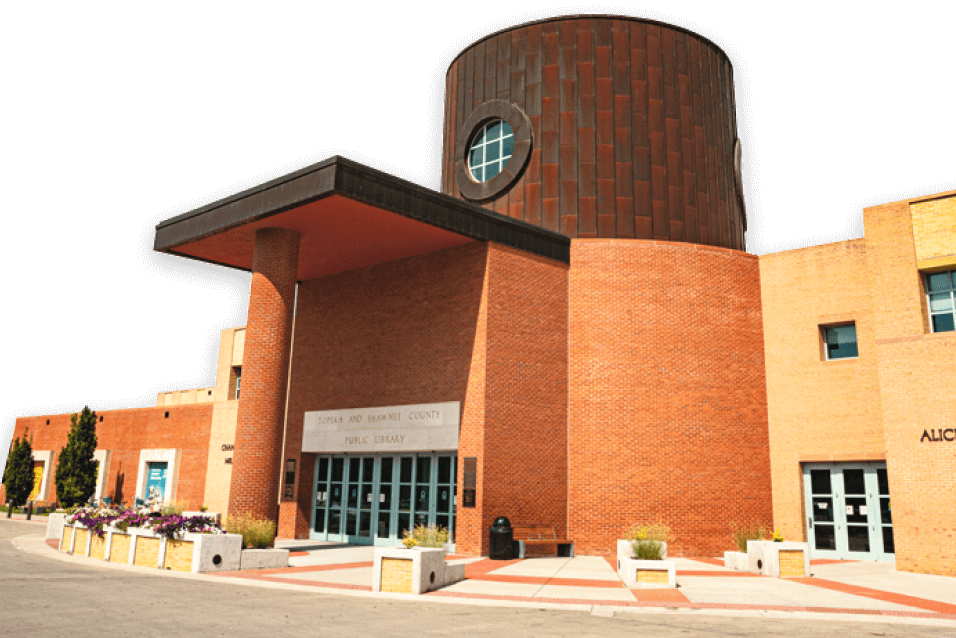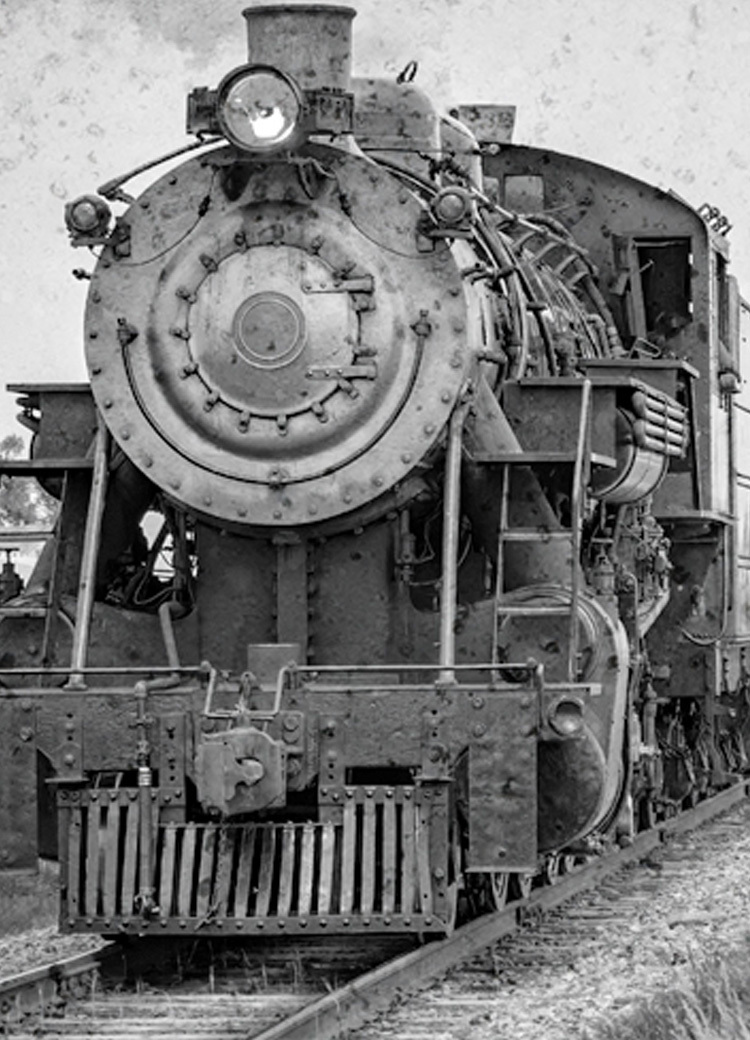Who built the railroad?
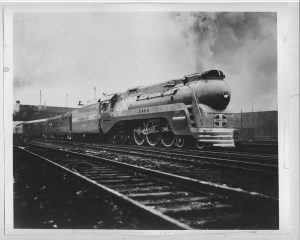
The Atchison, Topeka & Santa Fe Railway Company's Blue Goose #3460. Photo credit: Kansas State Historical Society
In late 2022, I started learning about the railroad in the U.S. and in Topeka, and wrote about it here: https://tscpl.org/history/railroad-history-choose-your-own-adventure. I had read a little bit about Cyrus K. Holliday and the beginning of the Santa Fe railroad. I also thought about other paths I could follow in the adventure of railroad history. Out of that list, I knew for sure I wanted to write something about railroad workers in general, and workers at the Santa Fe shops in Topeka specifically. So that's the first route I decided to try.
Cyrus K. Holliday wasn’t building the only railroad in the United States in the 1860s. Nearly all the railroads in the West were built between 1860 and 1890. By the time Holliday broke ground for the Atchison, Topeka, and Santa Fe Railroad (ATSF) in Fall of 1868, the Central Pacific Railroad was only about seven months away from being finished, in May of 1869. It was the first railroad to connect all the way to the west coast, stretching from Omaha, Nebraska, where it met up with existing rails all the way to Sacramento, California. But it was far from the last to be built.
Hell on wheels
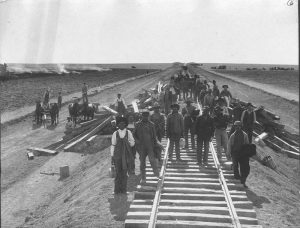
Atchison, Topeka, and Santa Fe railroad construction workers standing on tracks being built in Haskell County, Kansas. Photo credit: Kansas State Historical Society
More coast-to-coast lines were in progress, and even more regional rails. They all needed workers, lots of them, for jobs that were hard, dangerous and constantly on the move. By necessity, the people doing the building moved as the rails moved. “Hell on Wheels” towns formed at the end of the lines. These were tents and shanties that became home to restaurant and saloon keepers, gamblers, desperadoes of every grade, the vilest of men and of women, according to newspaper editor Samuel Bowles in 1869. I'd guess not all the workers appreciated this environment. But it was what they had to live with if they wanted the relatively high wages the railroad paid for what were considered unskilled jobs. I read that wages were better than average at the time, but they weren't sky high.
Many of the railroad workers immigrated to the United States and its territories. In the Northeast, early railroad workers were mostly Irish immigrants who came to escape the Great Famine of the 1840s. In the South, enslaved African Americans built the earliest railroads, and free African Americans worked the railroads after the Civil War.
Meanwhile, Chinese immigrants started building in California and worked toward the East. In Utah, Brigham Young, governor of the territory and leader of the Mormon church, didn't want Hell on Wheels towns to come to his community. Mormons built the railroad there, most of whom would have been born in the United States or its territories. In Topeka, immigrants also worked on the railroad. Here we finally arrive at my ulterior motive for writing about this topic.
Uncovering Mexican immigrants contributions to the Topeka railroad
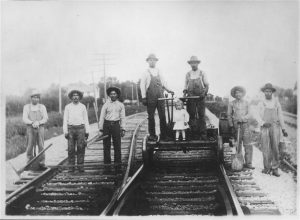
A section crew of Mexican laborers from the Atchison, Topeka and Santa Fe Railway Company near Pauline, Kansas. Standing beside the men is a young girl dressed in a white dress. Photo credit: Kansas State Historical Society
I knew some of the first Mexicans to migrate to this area worked on the railroad and I wanted to find out more about them. But I was having a hard time finding information when researching railroads. I looked at more than one history of the Atchison, Topeka and Santa Fe Railroad and didn't find anything except mentions of Irish workers. I looked for census statistics to tell me how many Mexican Americans were in Topeka in the early 1900s with no luck. Weird, I thought. I couldn't find anything. But even librarians sometimes look in the wrong place. I had to make a U-turn on my research journey.
Reversing my search
Instead of looking up railroads to find information about Mexican migrants, I decided to look for information about Mexican migrants and Mexican Americans in Kansas to see if I could find anything about railroads there. I checked out two books on the history of the Mexican and Mexican American community. I also checked out a book about the Bottoms, an area of downtown Topeka where Mexicans and other minority groups. They lived there in the 1850s until it was destroyed to build Interstate 70 in the 1960s.
Online, I quickly found this paragraph from the Kansas Hispanic and Latino American Affairs Commission. The fact is that, especially from 1900 to 1940, Mexican labor was an invaluable asset to the railroad industry, one that was perennially short of manpower. As members of an ethnic group, Mexicans have received no recognition for their substantial contribution to the growth of the state’s economy. In fact, in the three histories of the Santa Fe railroad written during this century, only one mentions Mexican labor, and that, in a quarter-page reference. Well, that explains why I didn't find much.
I also found out the census didn't ask about Mexican heritage until 1930, after the railroad boom was over. Before 1930 the census only had a category for Persons of Hispanic origin; where they lumped together everyone from Spain, all of Latin America and the Carribean. Not too helpful.
Neighborhood history
The Bottoms: a Place We Once Called Home by Thomas Rodriguez turned out to be the best source on this topic. It confirmed what I found online. It mentions that none of the many books written on railroads or the ATSF have more than a paragraph or two about the contributions of the thousands of Mexican laborers who helped them grow rich by building and maintaining their railroads. Unlike those books, The Bottoms has several pages of text and some photographs about the railroads, Mexican migration and La Yarda, the area where some of the very first Mexican railroad men in Topeka lived in boxcars due to lack of other housing.
Railroad employees in Shawnee County worked in the Santa Fe shops or in La Yarda on tracks in this region, so they didn't need to be mobile. The boxcars had no electricity, no running water and no kitchen (cooking facilities were separate). They weren't much more than a sheltered place to sleep. But it formed the beginning of the Mexican American community in Topeka, which eventually expanded to the Oakland neighborhood and beyond.
Conclusion
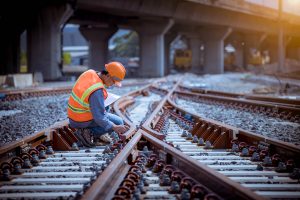 In the end, I didn’t find as much as I wanted to know about Topeka's Mexican American railroad workers and community. I was hoping for stories, in their own words, about their experiences working on the early railroad. I did meet my goal of learning more about railroad workers, and learned a little about immigration in the United States.
In the end, I didn’t find as much as I wanted to know about Topeka's Mexican American railroad workers and community. I was hoping for stories, in their own words, about their experiences working on the early railroad. I did meet my goal of learning more about railroad workers, and learned a little about immigration in the United States.
Sometimes the information you're looking for isn't where you'd expect it, or maybe not anywhere at all. This research path has hit a bit of a dead end. I'll have to go back and choose again.
Web sources


